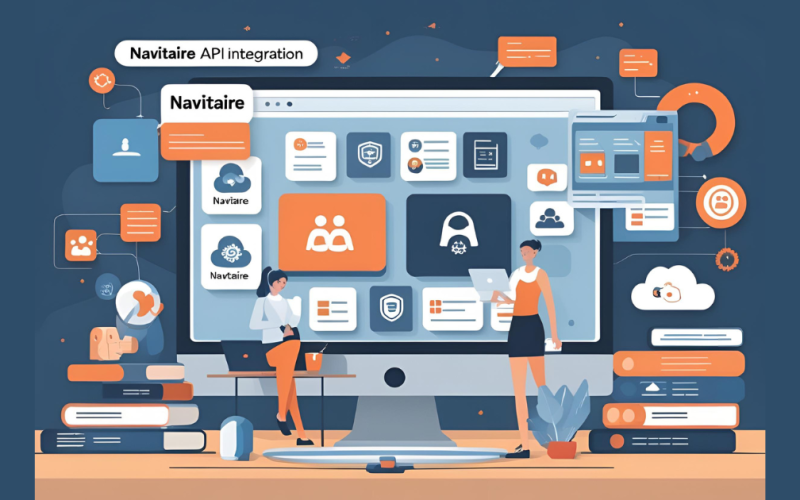In the evolving landscape of airline and travel tech, Navitaire API Integration Services have become a cornerstone for low-cost carriers, hybrid airlines, and travel platforms. These services enable real-time access to critical airline functionalities like bookings, seat inventory, check-in, and ancillary services.
However, integrating with Navitaire’s system is not a plug-and-play affair. From complex API logic and outdated documentation to stringent security protocols, developers and product managers face multiple hurdles during the integration process.
This article dives deep into the top challenges faced during Navitaire API integration and the proven solutions that help teams overcome them effectively.
What Are Navitaire API Integration Services?
Navitaire, owned by Amadeus, is a Passenger Service System (PSS) platform widely adopted by over 60 low-cost and hybrid carriers worldwide. It provides APIs that cover:
- Flight availability and reservations
- Fare pricing and ticketing
- Passenger data management and check-in
- Ancillary services and revenue enhancements
- Loyalty program integrations
Navitaire API Integration Services refer to the technical processes, tools, and platforms used to connect Navitaire’s backend systems with airline websites, mobile apps, OTAs, and third-party platforms.
Why Airlines and OTAs Use Navitaire APIs
Navitaire’s APIs are instrumental in digitalizing and modernizing airline operations. They offer a robust alternative to legacy GDS systems and are particularly suited for low-cost and budget carriers.
Key Advantages:
- Real-Time Booking & Availability – Instant access to seat inventory, pricing, and scheduling.
- Omnichannel Experience – Enables mobile apps and web platforms to function seamlessly.
- Ancillary Revenue Optimization – Supports add-ons like baggage, meals, seat selection.
- Personalized Offers – Allows targeted pricing and promotions.
- Secure and Scalable – Built to handle large volumes of real-time transactions.
Common Challenges in Navitaire API Integration
Despite its advantages, Navitaire integration is not without roadblocks. Let’s explore the most common issues faced by developers and solution architects.
1. Authentication & Security Complexities
Navitaire enforces strict authentication through token-based mechanisms and IP whitelisting. Managing session tokens, implementing SSL, and handling expiration logic can be challenging for teams unfamiliar with the platform.
Example Problem: Developers often experience unexpected token invalidation, leading to failed API calls during peak booking hours.
2. Limited or Confusing Documentation
While Navitaire provides technical documentation, it often lacks clarity, especially in terms of real-world use cases. This forces developers to experiment or seek help from support channels, increasing development time.
Example Problem: Functions like “Split Booking” or “Group Fare Management” require reverse engineering due to incomplete documentation.
3. Complex Business Logic
Every airline implements different fare rules, baggage policies, and seat maps. Mapping this variability to Navitaire’s rigid API structures is tedious and often results in non-standard implementations.
Example Problem: Managing multiple passenger types (adult, child, infant) across international routes with different fare conditions.
4. Handling Real-Time Data
Navitaire APIs are highly time-sensitive. Delays in network response or poor timeout handling can lead to inaccurate fare displays or booking failures.
Example Problem: A customer selects a fare only to find it unavailable during payment due to API response lag.
5. Error Handling and Debugging
Navitaire API errors can be cryptic, often returning generic messages without contextual hints. This makes identifying the root cause extremely difficult, especially in production environments.
Example Problem: An “Invalid Booking” error could stem from multiple issues—fare expiry, wrong passenger format, or missing SSR (Special Service Request) data.
6. Compatibility with Legacy Systems
Older internal systems or partner platforms may not support RESTful JSON APIs or modern encryption protocols. This creates friction in end-to-end data exchange.
Example Problem: A legacy accounting module fails to consume booking data pushed from Navitaire due to outdated XML schema.
7. Performance and Scalability
Navitaire enforces strict API rate limits and throttling mechanisms. Without careful performance tuning and load testing, systems can face cascading failures during peak demand.
Example Problem: A flash sale leads to API throttling and mass booking failures within 5 minutes.
Solutions to Overcome Navitaire API Integration Challenges
1. Implement Secure API Gateways
Deploy a robust API gateway that handles token generation, renewal, and IP management centrally. This abstracts the complexity from downstream systems and ensures consistent authentication flow.
Recommended Tools: AWS API Gateway, Kong, NGINX Plus
2. Build Middleware for Data Normalization
Introduce a middleware layer that adapts Navitaire’s native schema into your own internal format. This isolates your business logic from API changes and makes systems more maintainable.
Benefits: Simplifies integration with CMS, ERP, mobile apps.
3. Develop Detailed Logging and Monitoring Systems
Implement real-time logging to track API requests, response times, error codes, and user behaviors. Pair this with proactive monitoring and alerting to detect anomalies early.
Tools: ELK Stack, Datadog, Sentry, New Relic
4. Partner with Navitaire Integration Experts
Collaborate with certified Navitaire service providers or developers who have deep experience. They understand edge cases, optimize configurations, and reduce time-to-market.
Outcome: Fewer errors, faster deployment, better maintainability.
5. Conduct Load Testing and API Profiling
Before going live, simulate real-world load using JMeter or Gatling. Profile each endpoint and fine-tune retry policies, caching strategies, and parallel requests.
Outcome: Predictable behavior during peak travel periods.
Best Practices for Navitaire API Integration
- Use sandbox environments before touching production systems.
- Cache static data like airport codes, aircraft types, and fare classes.
- Batch calls efficiently to reduce round-trips and latency.
- Plan for fallbacks and retries using circuit breaker patterns.
- Automate API schema validation with tools like Postman/Newman or Swagger.
- Version control your API connectors for traceable changes and rollbacks.
Conclusion
Navitaire API Integration Services can power highly responsive, scalable, and customer-centric travel solutions—but only when implemented with foresight and strategy. The challenges are real: from poor documentation to real-time failures—but so are the solutions.
Whether you’re building a new airline app or modernizing a legacy travel portal, tackling these integration issues with structured planning, the right tools, and experienced developers will dramatically improve your odds of success.
FAQs
Q1. How long does it take to complete a Navitaire API integration?
The typical duration ranges from 4 to 12 weeks depending on the complexity of the use case and your team’s familiarity with the platform.
Q2. Are there SDKs available for Navitaire APIs?
Navitaire does not offer public SDKs, but certified partners may provide wrappers and libraries for rapid development.
Q3. Can Navitaire APIs support mobile booking apps?
Yes, Navitaire APIs are mobile-compatible and support dynamic inventory, booking, and check-in capabilities for Android and iOS apps.
Q4. What are the most common issues during integration?
Authentication errors, insufficient documentation, and real-time data handling failures are among the most frequent pain points.
Q5. Do I need to get approval from Navitaire before accessing APIs?
Yes, Navitaire APIs are not open/public APIs. You must sign agreements and request sandbox access via their official channels.











